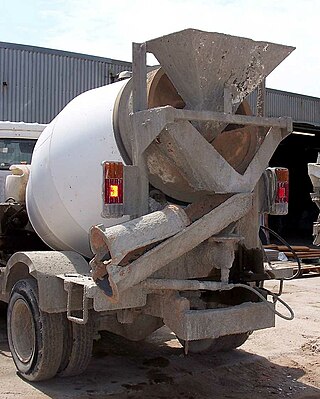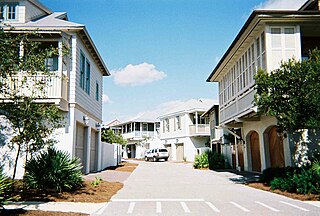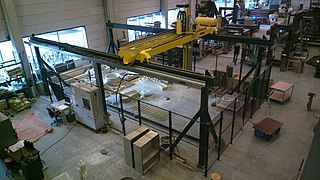Related Research Articles

Concrete is a composite material composed of aggregate bonded together with a fluid cement that cures over time. Concrete is the second-most-used substance in the world after water, and is the most widely used building material. Its usage worldwide, ton for ton, is twice that of steel, wood, plastics, and aluminium combined.

A cement is a binder, a chemical substance used for construction that sets, hardens, and adheres to other materials to bind them together. Cement is seldom used on its own, but rather to bind sand and gravel (aggregate) together. Cement mixed with fine aggregate produces mortar for masonry, or with sand and gravel, produces concrete. Concrete is the most widely used material in existence and is behind only water as the planet's most-consumed resource.

Portland cement is the most common type of cement in general use around the world as a basic ingredient of concrete, mortar, stucco, and non-specialty grout. It was developed from other types of hydraulic lime in England in the early 19th century by Joseph Aspdin, and is usually made from limestone. It is a fine powder, produced by heating limestone and clay minerals in a kiln to form clinker, grinding the clinker, and adding 2 to 3 percent of gypsum. Several types of portland cement are available. The most common, called ordinary portland cement (OPC), is grey, but white portland cement is also available. Its name is derived from its resemblance to Portland stone which is quarried on the Isle of Portland in Dorset, England. It was named by Joseph Aspdin who obtained a patent for it in 1824. His son William Aspdin is regarded as the inventor of "modern" portland cement due to his developments in the 1840s.

Slag is a by-product of smelting (pyrometallurgical) ores and recycled metals. Slag is mainly a mixture of metal oxides and silicon dioxide. Broadly, it can be classified as ferrous, ferroalloy or non-ferrous/base metals. Within these general categories, slags can be further categorized by their precursor and processing conditions. "Slag generated from the EAF process can contain toxic metals, which can be hazardous to human and environmental health".

Building material is material used for construction. Many naturally occurring substances, such as clay, rocks, sand, wood, and even twigs and leaves, have been used to construct buildings and other structures, like bridges. Apart from naturally occurring materials, many man-made products are in use, some more and some less synthetic. The manufacturing of building materials is an established industry in many countries and the use of these materials is typically segmented into specific specialty trades, such as carpentry, insulation, plumbing, and roofing work. They provide the make-up of habitats and structures including homes.

Ready-mix concrete (RMC) is concrete that is manufactured in a batch plant, according to each specific job requirement, then delivered to the job site "ready to use".
The water–cement ratio is the ratio of the mass of water to the mass of cement used in a concrete mix:

Ground granulated blast-furnace slag is obtained by quenching molten iron slag from a blast furnace in water or steam, to produce a glassy, granular product that is then dried and ground into a fine powder. Ground granulated blast furnace slag is a latent hydraulic binder forming calcium silicate hydrates (C-S-H) after contact with water. It is a strength-enhancing compound improving the durability of concrete. It is a component of metallurgic cement. Its main advantage is its slow release of hydration heat, allowing limitation of the temperature increase in massive concrete components and structures during cement setting and concrete curing, or to cast concrete during hot summer.

Construction aggregate, or simply aggregate, is a broad category of coarse- to medium-grained particulate material used in construction, including sand, gravel, crushed stone, slag, recycled concrete and geosynthetic aggregates. Aggregates are the most mined materials in the world. Aggregates are a component of composite materials such as concrete and asphalt; the aggregate serves as reinforcement to add strength to the overall composite material. Due to the relatively high hydraulic conductivity value as compared to most soils, aggregates are widely used in drainage applications such as foundation and French drains, septic drain fields, retaining wall drains, and roadside edge drains. Aggregates are also used as base material under foundations, roads, and railroads. In other words, aggregates are used as a stable foundation or road/rail base with predictable, uniform properties, or as a low-cost extender that binds with more expensive cement or asphalt to form concrete. Although most kinds of aggregate require a form of binding agent, there are types of self-binding aggregate which require no form of binding agent.

A compressed earth block (CEB), also known as a pressed earth block or a compressed soil block, is a building material made primarily from an appropriate mix of fairly dry inorganic subsoil, non-expansive clay, sand, and aggregate. Forming compressed earth blocks requires dampening, mechanically pressing at high pressure, and then drying the resulting material. If the blocks are stabilized with a chemical binder such as Portland cement they are called compressed stabilized earth block (CSEB) or stabilized earth block (SEB). Typically, around 3,000 psi (21 MPa) of pressure is applied in compression, and the original material volume is reduced by about half.

Pervious concrete is a special type of concrete with a high porosity used for concrete flatwork applications that allows water from precipitation and other sources to pass directly through, thereby reducing the runoff from a site and allowing groundwater recharge.
White Portland cement or white ordinary Portland cement (WOPC) is similar to ordinary, gray Portland cement in all aspects except for its high degree of whiteness. Obtaining this color requires substantial modifications to the method of manufacturing. It requires a much lower content in colored impurities in the raw materials used to produce clinker: low levels of Cr2O3, Mn2O3, and Fe2O3), but above all, a higher temperature is needed for the final sintering step in the cement kiln because of the higher melting point of the mix depleted in iron oxides. Because of this, the process is more energy demanding and the white cement is somewhat more expensive than the gray product.

Hempcrete or hemplime is biocomposite material, a mixture of hemp hurds (shives) and lime, sand, or pozzolans, which is used as a material for construction and insulation. It is marketed under names like Hempcrete, Canobiote, Canosmose, Isochanvre and IsoHemp. Hempcrete is easier to work with than traditional lime mixes and acts as an insulator and moisture regulator. It lacks the brittleness of concrete and consequently does not need expansion joints.
Lunarcrete, also known as "mooncrete", an idea first proposed by Larry A. Beyer of the University of Pittsburgh in 1985, is a hypothetical construction aggregate, similar to concrete, formed from lunar regolith, that would reduce the construction costs of building on the Moon. AstroCrete is a more general concept also applicable for Mars.

Concrete is produced in a variety of compositions, finishes and performance characteristics to meet a wide range of needs.
Concrete has relatively high compressive strength, but significantly lower tensile strength. The compressive strength is typically controlled with the ratio of water to cement when forming the concrete, and tensile strength is increased by additives, typically steel, to create reinforced concrete. In other words we can say concrete is made up of sand, ballast, cement and water.
A traditional method for the installation of tile and stone which involves setting the tile or stone into a mortar bed which has been packed over a surface.
Waste light concrete (WLC) is a type of light weight concrete where the traditional construction aggregates are replaced by a mix of shredded waste materials and a special group of additives. Used in infrastructure and building construction.

3D concrete printing, or simply concrete printing, refers to digital fabrication processes for cementitious materials based on one of several different 3D printing technologies. 3D-printed concrete eliminates the need for formwork, reducing material waste and allowing for greater geometric freedom in complex structures. With recent developments in mix design and 3D printing technology over the last decade, 3D concrete printing has grown exponentially since its emergence in the 1990s. Architectural and structural applications of 3D-printed concrete include the production of building blocks, building modules, street furniture, pedestrian bridges, and low-rise residential structures.
References
- ↑ Zhang, Q., Zhang, B., & Wang, D. (2022). Environmental benefit assessment of blended cement with modified granulated copper slag. Materials, 15(15), 5359. https://doi.org/10.3390/ma15155359
- ↑ Vijayaraghavan, J., Jude, A. B., & Thivya, J. (2017). Effect of copper slag, iron slag and recycled concrete aggregate on the mechanical properties of concrete. Resources Policy, 53, 219–225. https://doi.org/10.1016/j.resourpol.2017.06.012
- ↑ Vijayaraghavan, J., Jude, A. B., & Thivya, J. (2017). Effect of copper slag, iron slag and recycled concrete aggregate on the mechanical properties of concrete. Resources Policy, 53, 219–225. https://doi.org/10.1016/j.resourpol.2017.06.012
- ↑ ISO 11126-3:1993 Preparation of steel substrates before application of paints and related products -- Specifications for non-metallic blast-cleaning abrasives -- Part 3: Copper refinery slag: Preparation of Steel Substrates Before Application of Paints and Related Products.
- ↑ Ferguson, John (1996). "The Copper Slag Blocks of Hale" (PDF). Mining History. 13 (2). Peak District Mines Historical Society. Archived from the original (PDF) on 2016-03-04. Retrieved 2015-12-28.
- ↑ "Startsida". Järnsand (in Swedish). Retrieved 2021-08-12.
- ↑ Rasoul Abdar Esfahani, S. M., Zareei, S. A., Madhkhan, M., Ameri, F., Rashidiani, J., & Taheri, R. A. (2021). Mechanical and gamma-ray shielding properties and environmental benefits of concrete incorporating GGBFS and copper slag. Journal of Building Engineering, 33, 101615. https://doi.org/10.1016/j.jobe.2020.101615